Business Policy Analysis: Netflix Company Performance Report
VerifiedAdded on 2020/03/28
|14
|3551
|42
Report
AI Summary
This report provides a comprehensive analysis of Netflix, a leading entertainment company specializing in DVD by mail, video-on-demand, and video streaming media. It begins with a historical overview, tracing the company's establishment in 1997 by Marc Randolph and Reed Hastings, and its evolution into a global entertainment giant. The report outlines the purpose of Netflix, highlighting its focus on customer satisfaction, forward investment, and cost savings. It then delves into the current issues affecting the company, including financial constraints, competition from rivals like Redbox, and challenges related to the FCC Open Internet ban. An economic analysis of Netflix is presented, examining its market share, business model, and competitive advantages. The report concludes by discussing the limitations of the enterprise and its future prospects in the rapidly evolving entertainment landscape. The report also explores Netflix's business strategies, marketing approaches, and product differentiation to maintain its market position.
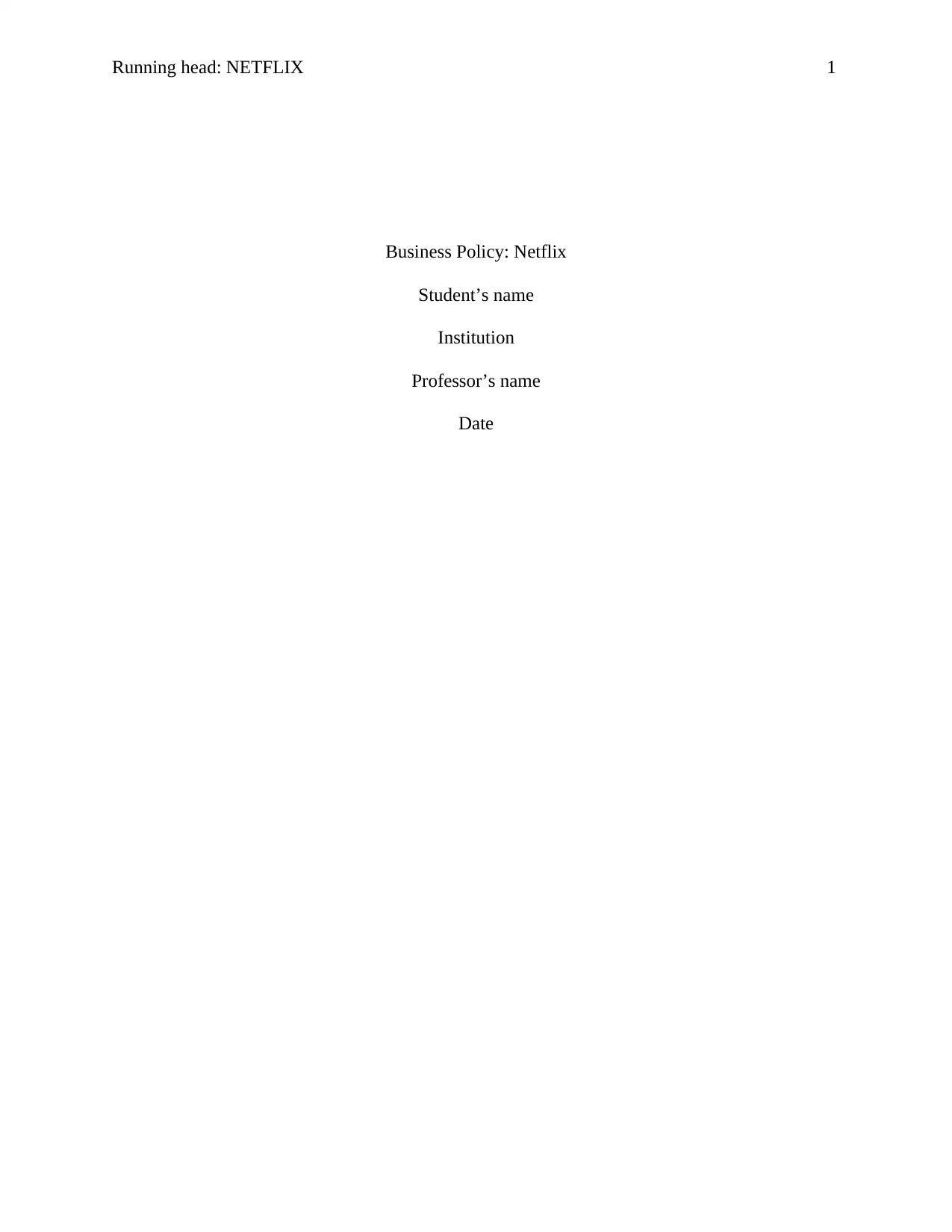
Running head: NETFLIX 1
Business Policy: Netflix
Student’s name
Institution
Professor’s name
Date
Business Policy: Netflix
Student’s name
Institution
Professor’s name
Date
Paraphrase This Document
Need a fresh take? Get an instant paraphrase of this document with our AI Paraphraser
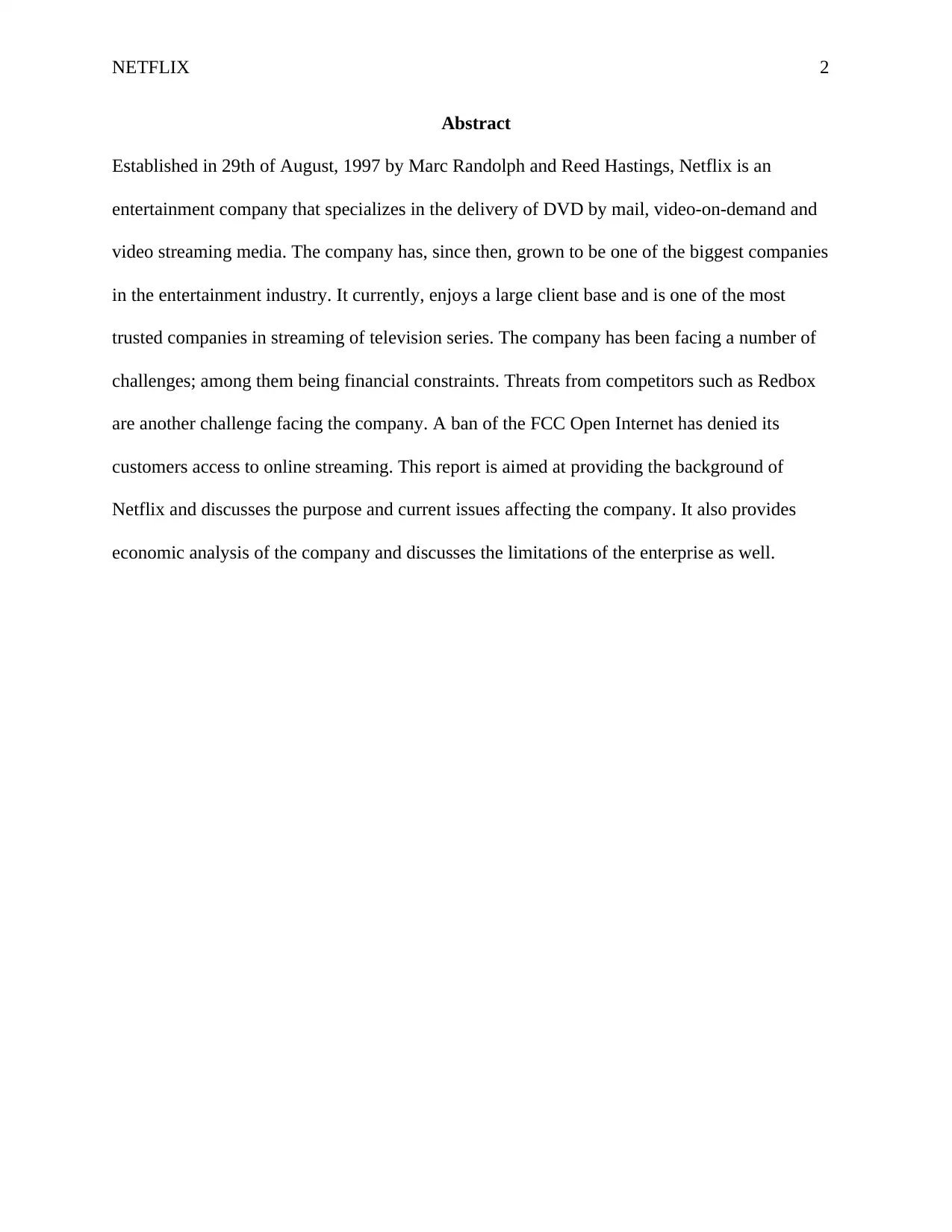
NETFLIX 2
Abstract
Established in 29th of August, 1997 by Marc Randolph and Reed Hastings, Netflix is an
entertainment company that specializes in the delivery of DVD by mail, video-on-demand and
video streaming media. The company has, since then, grown to be one of the biggest companies
in the entertainment industry. It currently, enjoys a large client base and is one of the most
trusted companies in streaming of television series. The company has been facing a number of
challenges; among them being financial constraints. Threats from competitors such as Redbox
are another challenge facing the company. A ban of the FCC Open Internet has denied its
customers access to online streaming. This report is aimed at providing the background of
Netflix and discusses the purpose and current issues affecting the company. It also provides
economic analysis of the company and discusses the limitations of the enterprise as well.
Abstract
Established in 29th of August, 1997 by Marc Randolph and Reed Hastings, Netflix is an
entertainment company that specializes in the delivery of DVD by mail, video-on-demand and
video streaming media. The company has, since then, grown to be one of the biggest companies
in the entertainment industry. It currently, enjoys a large client base and is one of the most
trusted companies in streaming of television series. The company has been facing a number of
challenges; among them being financial constraints. Threats from competitors such as Redbox
are another challenge facing the company. A ban of the FCC Open Internet has denied its
customers access to online streaming. This report is aimed at providing the background of
Netflix and discusses the purpose and current issues affecting the company. It also provides
economic analysis of the company and discusses the limitations of the enterprise as well.
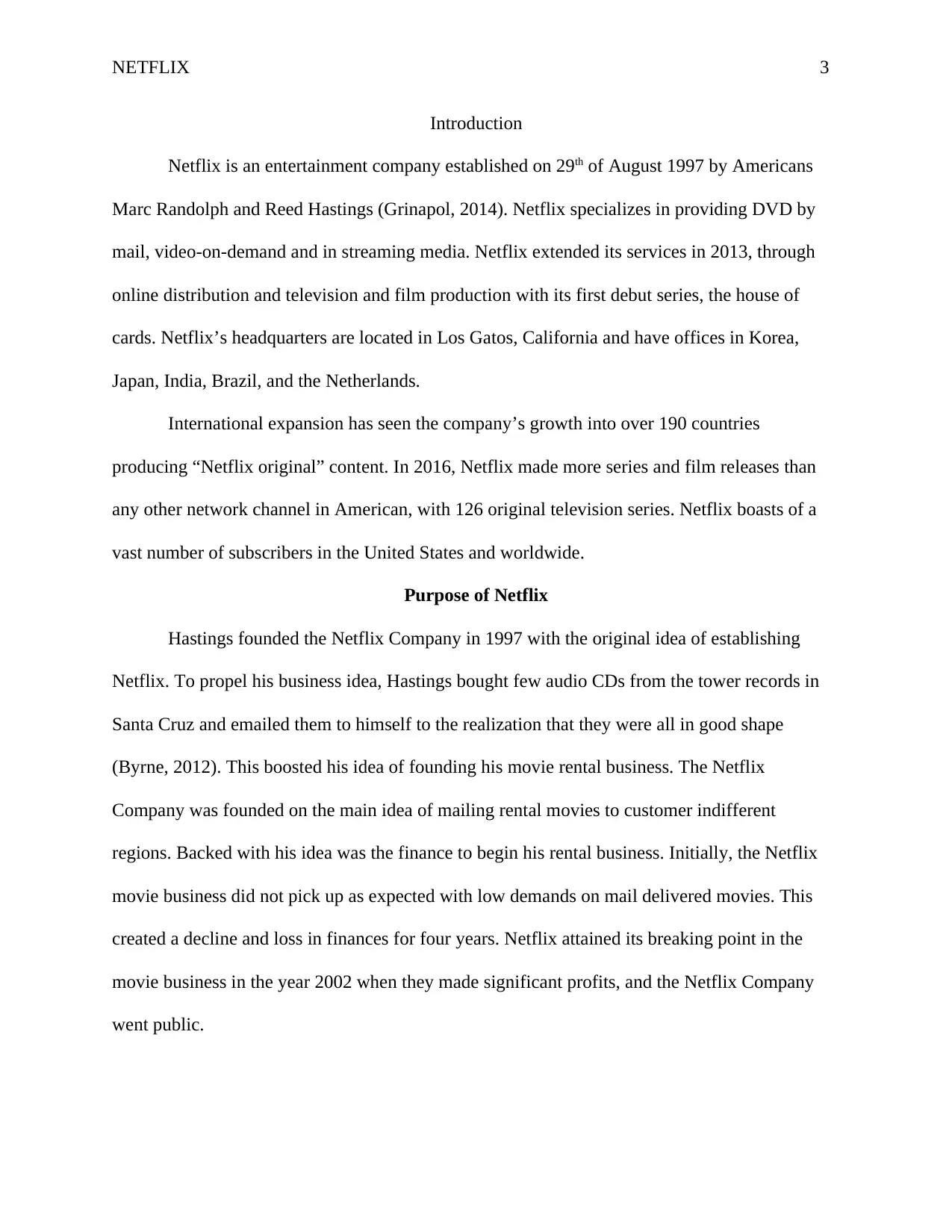
NETFLIX 3
Introduction
Netflix is an entertainment company established on 29th of August 1997 by Americans
Marc Randolph and Reed Hastings (Grinapol, 2014). Netflix specializes in providing DVD by
mail, video-on-demand and in streaming media. Netflix extended its services in 2013, through
online distribution and television and film production with its first debut series, the house of
cards. Netflix’s headquarters are located in Los Gatos, California and have offices in Korea,
Japan, India, Brazil, and the Netherlands.
International expansion has seen the company’s growth into over 190 countries
producing “Netflix original” content. In 2016, Netflix made more series and film releases than
any other network channel in American, with 126 original television series. Netflix boasts of a
vast number of subscribers in the United States and worldwide.
Purpose of Netflix
Hastings founded the Netflix Company in 1997 with the original idea of establishing
Netflix. To propel his business idea, Hastings bought few audio CDs from the tower records in
Santa Cruz and emailed them to himself to the realization that they were all in good shape
(Byrne, 2012). This boosted his idea of founding his movie rental business. The Netflix
Company was founded on the main idea of mailing rental movies to customer indifferent
regions. Backed with his idea was the finance to begin his rental business. Initially, the Netflix
movie business did not pick up as expected with low demands on mail delivered movies. This
created a decline and loss in finances for four years. Netflix attained its breaking point in the
movie business in the year 2002 when they made significant profits, and the Netflix Company
went public.
Introduction
Netflix is an entertainment company established on 29th of August 1997 by Americans
Marc Randolph and Reed Hastings (Grinapol, 2014). Netflix specializes in providing DVD by
mail, video-on-demand and in streaming media. Netflix extended its services in 2013, through
online distribution and television and film production with its first debut series, the house of
cards. Netflix’s headquarters are located in Los Gatos, California and have offices in Korea,
Japan, India, Brazil, and the Netherlands.
International expansion has seen the company’s growth into over 190 countries
producing “Netflix original” content. In 2016, Netflix made more series and film releases than
any other network channel in American, with 126 original television series. Netflix boasts of a
vast number of subscribers in the United States and worldwide.
Purpose of Netflix
Hastings founded the Netflix Company in 1997 with the original idea of establishing
Netflix. To propel his business idea, Hastings bought few audio CDs from the tower records in
Santa Cruz and emailed them to himself to the realization that they were all in good shape
(Byrne, 2012). This boosted his idea of founding his movie rental business. The Netflix
Company was founded on the main idea of mailing rental movies to customer indifferent
regions. Backed with his idea was the finance to begin his rental business. Initially, the Netflix
movie business did not pick up as expected with low demands on mail delivered movies. This
created a decline and loss in finances for four years. Netflix attained its breaking point in the
movie business in the year 2002 when they made significant profits, and the Netflix Company
went public.
⊘ This is a preview!⊘
Do you want full access?
Subscribe today to unlock all pages.

Trusted by 1+ million students worldwide
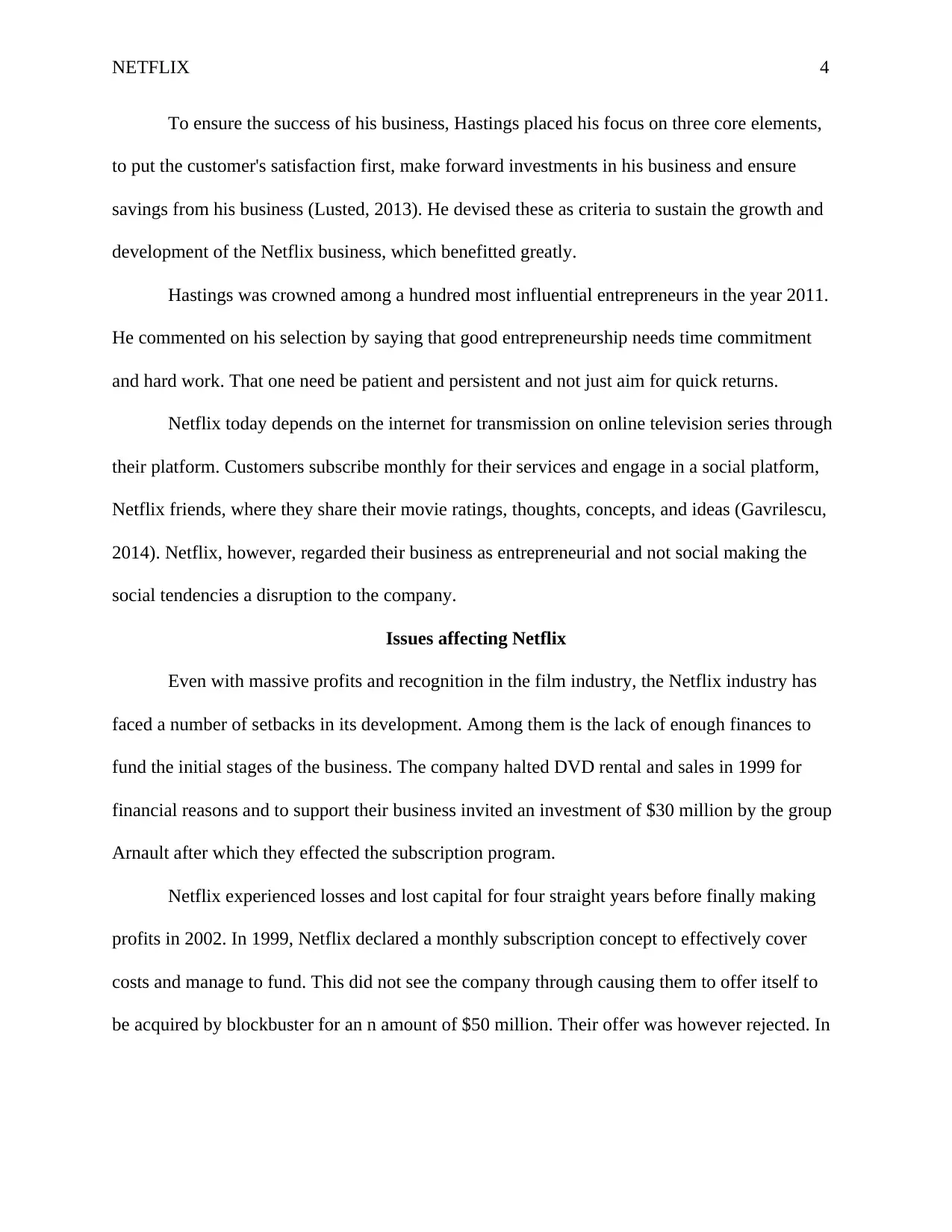
NETFLIX 4
To ensure the success of his business, Hastings placed his focus on three core elements,
to put the customer's satisfaction first, make forward investments in his business and ensure
savings from his business (Lusted, 2013). He devised these as criteria to sustain the growth and
development of the Netflix business, which benefitted greatly.
Hastings was crowned among a hundred most influential entrepreneurs in the year 2011.
He commented on his selection by saying that good entrepreneurship needs time commitment
and hard work. That one need be patient and persistent and not just aim for quick returns.
Netflix today depends on the internet for transmission on online television series through
their platform. Customers subscribe monthly for their services and engage in a social platform,
Netflix friends, where they share their movie ratings, thoughts, concepts, and ideas (Gavrilescu,
2014). Netflix, however, regarded their business as entrepreneurial and not social making the
social tendencies a disruption to the company.
Issues affecting Netflix
Even with massive profits and recognition in the film industry, the Netflix industry has
faced a number of setbacks in its development. Among them is the lack of enough finances to
fund the initial stages of the business. The company halted DVD rental and sales in 1999 for
financial reasons and to support their business invited an investment of $30 million by the group
Arnault after which they effected the subscription program.
Netflix experienced losses and lost capital for four straight years before finally making
profits in 2002. In 1999, Netflix declared a monthly subscription concept to effectively cover
costs and manage to fund. This did not see the company through causing them to offer itself to
be acquired by blockbuster for an n amount of $50 million. Their offer was however rejected. In
To ensure the success of his business, Hastings placed his focus on three core elements,
to put the customer's satisfaction first, make forward investments in his business and ensure
savings from his business (Lusted, 2013). He devised these as criteria to sustain the growth and
development of the Netflix business, which benefitted greatly.
Hastings was crowned among a hundred most influential entrepreneurs in the year 2011.
He commented on his selection by saying that good entrepreneurship needs time commitment
and hard work. That one need be patient and persistent and not just aim for quick returns.
Netflix today depends on the internet for transmission on online television series through
their platform. Customers subscribe monthly for their services and engage in a social platform,
Netflix friends, where they share their movie ratings, thoughts, concepts, and ideas (Gavrilescu,
2014). Netflix, however, regarded their business as entrepreneurial and not social making the
social tendencies a disruption to the company.
Issues affecting Netflix
Even with massive profits and recognition in the film industry, the Netflix industry has
faced a number of setbacks in its development. Among them is the lack of enough finances to
fund the initial stages of the business. The company halted DVD rental and sales in 1999 for
financial reasons and to support their business invited an investment of $30 million by the group
Arnault after which they effected the subscription program.
Netflix experienced losses and lost capital for four straight years before finally making
profits in 2002. In 1999, Netflix declared a monthly subscription concept to effectively cover
costs and manage to fund. This did not see the company through causing them to offer itself to
be acquired by blockbuster for an n amount of $50 million. Their offer was however rejected. In
Paraphrase This Document
Need a fresh take? Get an instant paraphrase of this document with our AI Paraphraser
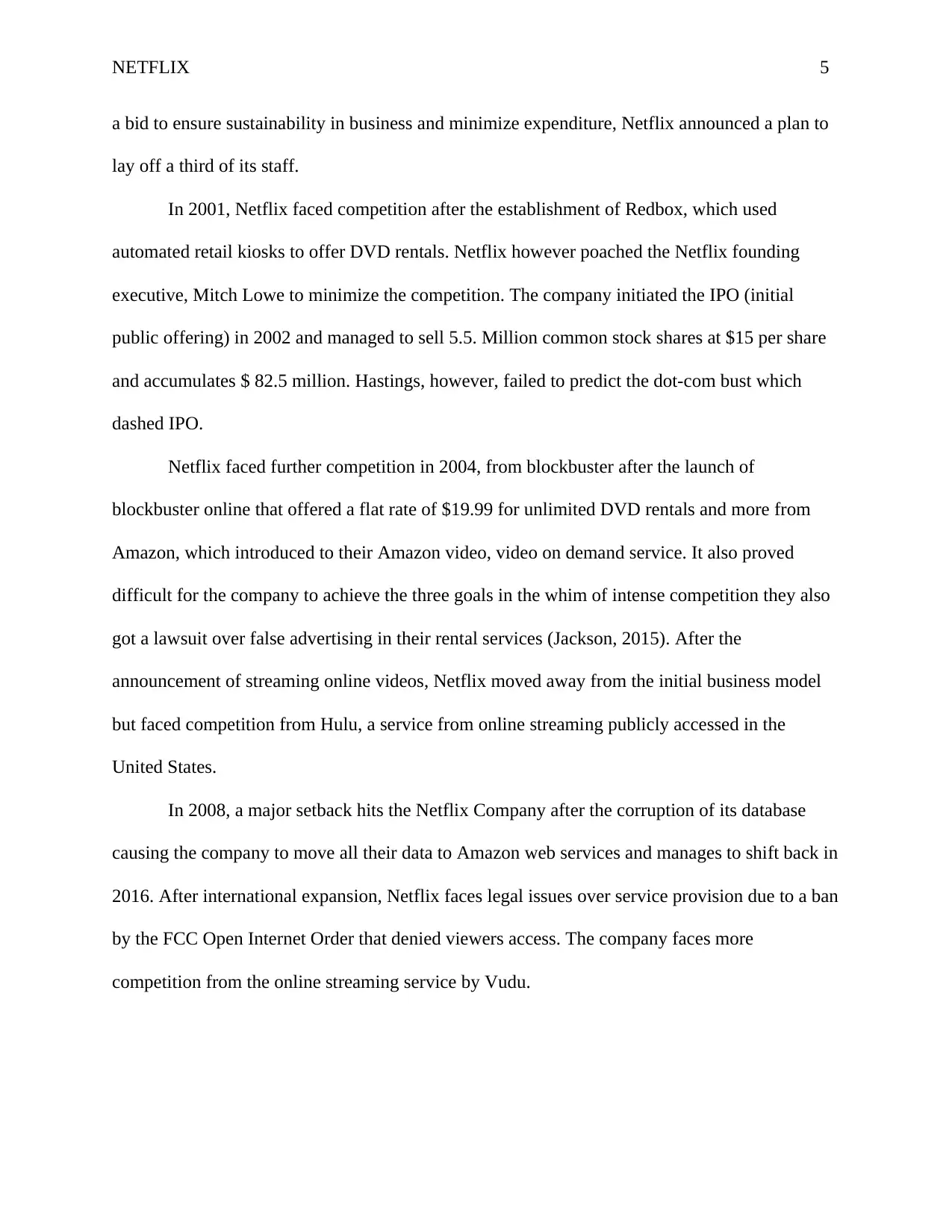
NETFLIX 5
a bid to ensure sustainability in business and minimize expenditure, Netflix announced a plan to
lay off a third of its staff.
In 2001, Netflix faced competition after the establishment of Redbox, which used
automated retail kiosks to offer DVD rentals. Netflix however poached the Netflix founding
executive, Mitch Lowe to minimize the competition. The company initiated the IPO (initial
public offering) in 2002 and managed to sell 5.5. Million common stock shares at $15 per share
and accumulates $ 82.5 million. Hastings, however, failed to predict the dot-com bust which
dashed IPO.
Netflix faced further competition in 2004, from blockbuster after the launch of
blockbuster online that offered a flat rate of $19.99 for unlimited DVD rentals and more from
Amazon, which introduced to their Amazon video, video on demand service. It also proved
difficult for the company to achieve the three goals in the whim of intense competition they also
got a lawsuit over false advertising in their rental services (Jackson, 2015). After the
announcement of streaming online videos, Netflix moved away from the initial business model
but faced competition from Hulu, a service from online streaming publicly accessed in the
United States.
In 2008, a major setback hits the Netflix Company after the corruption of its database
causing the company to move all their data to Amazon web services and manages to shift back in
2016. After international expansion, Netflix faces legal issues over service provision due to a ban
by the FCC Open Internet Order that denied viewers access. The company faces more
competition from the online streaming service by Vudu.
a bid to ensure sustainability in business and minimize expenditure, Netflix announced a plan to
lay off a third of its staff.
In 2001, Netflix faced competition after the establishment of Redbox, which used
automated retail kiosks to offer DVD rentals. Netflix however poached the Netflix founding
executive, Mitch Lowe to minimize the competition. The company initiated the IPO (initial
public offering) in 2002 and managed to sell 5.5. Million common stock shares at $15 per share
and accumulates $ 82.5 million. Hastings, however, failed to predict the dot-com bust which
dashed IPO.
Netflix faced further competition in 2004, from blockbuster after the launch of
blockbuster online that offered a flat rate of $19.99 for unlimited DVD rentals and more from
Amazon, which introduced to their Amazon video, video on demand service. It also proved
difficult for the company to achieve the three goals in the whim of intense competition they also
got a lawsuit over false advertising in their rental services (Jackson, 2015). After the
announcement of streaming online videos, Netflix moved away from the initial business model
but faced competition from Hulu, a service from online streaming publicly accessed in the
United States.
In 2008, a major setback hits the Netflix Company after the corruption of its database
causing the company to move all their data to Amazon web services and manages to shift back in
2016. After international expansion, Netflix faces legal issues over service provision due to a ban
by the FCC Open Internet Order that denied viewers access. The company faces more
competition from the online streaming service by Vudu.
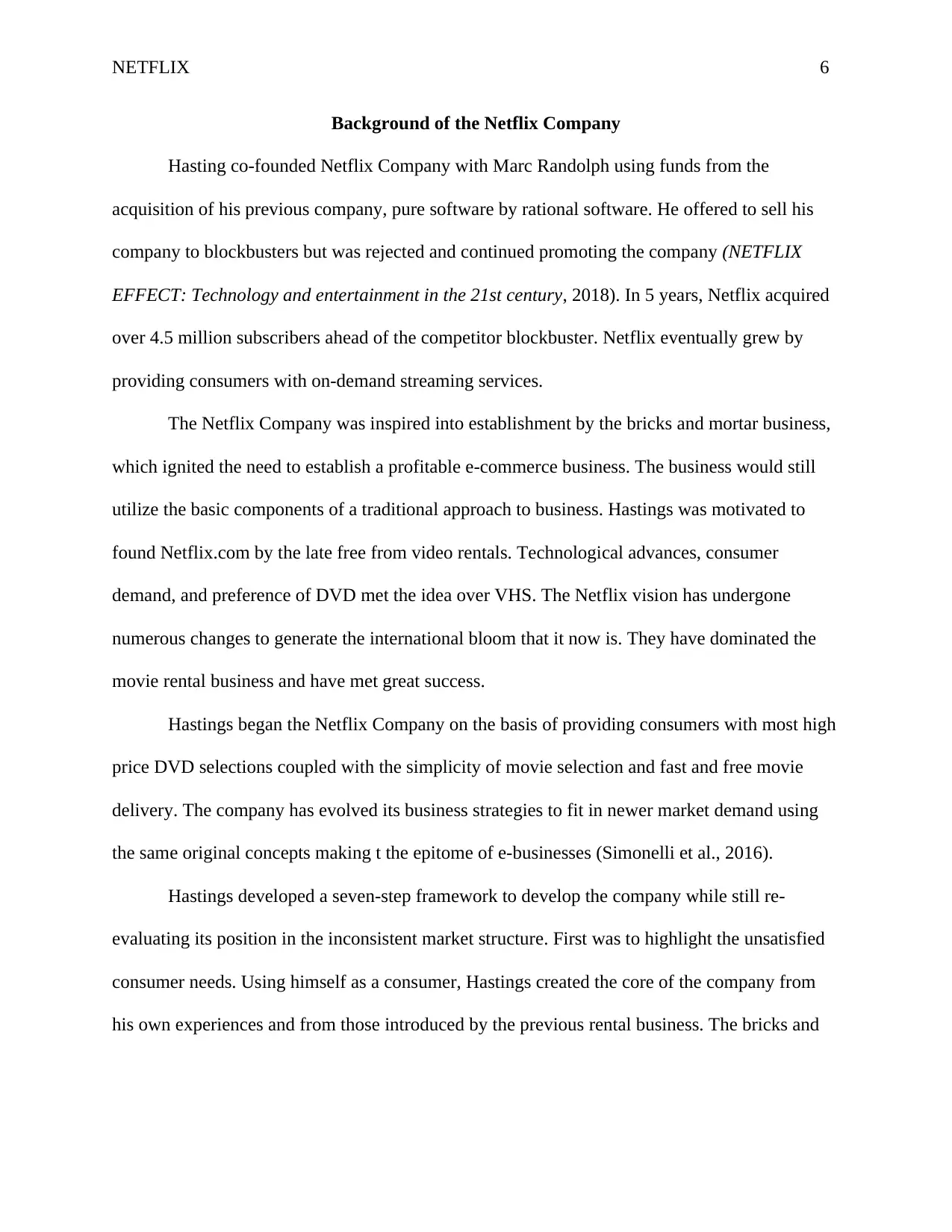
NETFLIX 6
Background of the Netflix Company
Hasting co-founded Netflix Company with Marc Randolph using funds from the
acquisition of his previous company, pure software by rational software. He offered to sell his
company to blockbusters but was rejected and continued promoting the company (NETFLIX
EFFECT: Technology and entertainment in the 21st century, 2018). In 5 years, Netflix acquired
over 4.5 million subscribers ahead of the competitor blockbuster. Netflix eventually grew by
providing consumers with on-demand streaming services.
The Netflix Company was inspired into establishment by the bricks and mortar business,
which ignited the need to establish a profitable e-commerce business. The business would still
utilize the basic components of a traditional approach to business. Hastings was motivated to
found Netflix.com by the late free from video rentals. Technological advances, consumer
demand, and preference of DVD met the idea over VHS. The Netflix vision has undergone
numerous changes to generate the international bloom that it now is. They have dominated the
movie rental business and have met great success.
Hastings began the Netflix Company on the basis of providing consumers with most high
price DVD selections coupled with the simplicity of movie selection and fast and free movie
delivery. The company has evolved its business strategies to fit in newer market demand using
the same original concepts making t the epitome of e-businesses (Simonelli et al., 2016).
Hastings developed a seven-step framework to develop the company while still re-
evaluating its position in the inconsistent market structure. First was to highlight the unsatisfied
consumer needs. Using himself as a consumer, Hastings created the core of the company from
his own experiences and from those introduced by the previous rental business. The bricks and
Background of the Netflix Company
Hasting co-founded Netflix Company with Marc Randolph using funds from the
acquisition of his previous company, pure software by rational software. He offered to sell his
company to blockbusters but was rejected and continued promoting the company (NETFLIX
EFFECT: Technology and entertainment in the 21st century, 2018). In 5 years, Netflix acquired
over 4.5 million subscribers ahead of the competitor blockbuster. Netflix eventually grew by
providing consumers with on-demand streaming services.
The Netflix Company was inspired into establishment by the bricks and mortar business,
which ignited the need to establish a profitable e-commerce business. The business would still
utilize the basic components of a traditional approach to business. Hastings was motivated to
found Netflix.com by the late free from video rentals. Technological advances, consumer
demand, and preference of DVD met the idea over VHS. The Netflix vision has undergone
numerous changes to generate the international bloom that it now is. They have dominated the
movie rental business and have met great success.
Hastings began the Netflix Company on the basis of providing consumers with most high
price DVD selections coupled with the simplicity of movie selection and fast and free movie
delivery. The company has evolved its business strategies to fit in newer market demand using
the same original concepts making t the epitome of e-businesses (Simonelli et al., 2016).
Hastings developed a seven-step framework to develop the company while still re-
evaluating its position in the inconsistent market structure. First was to highlight the unsatisfied
consumer needs. Using himself as a consumer, Hastings created the core of the company from
his own experiences and from those introduced by the previous rental business. The bricks and
⊘ This is a preview!⊘
Do you want full access?
Subscribe today to unlock all pages.

Trusted by 1+ million students worldwide
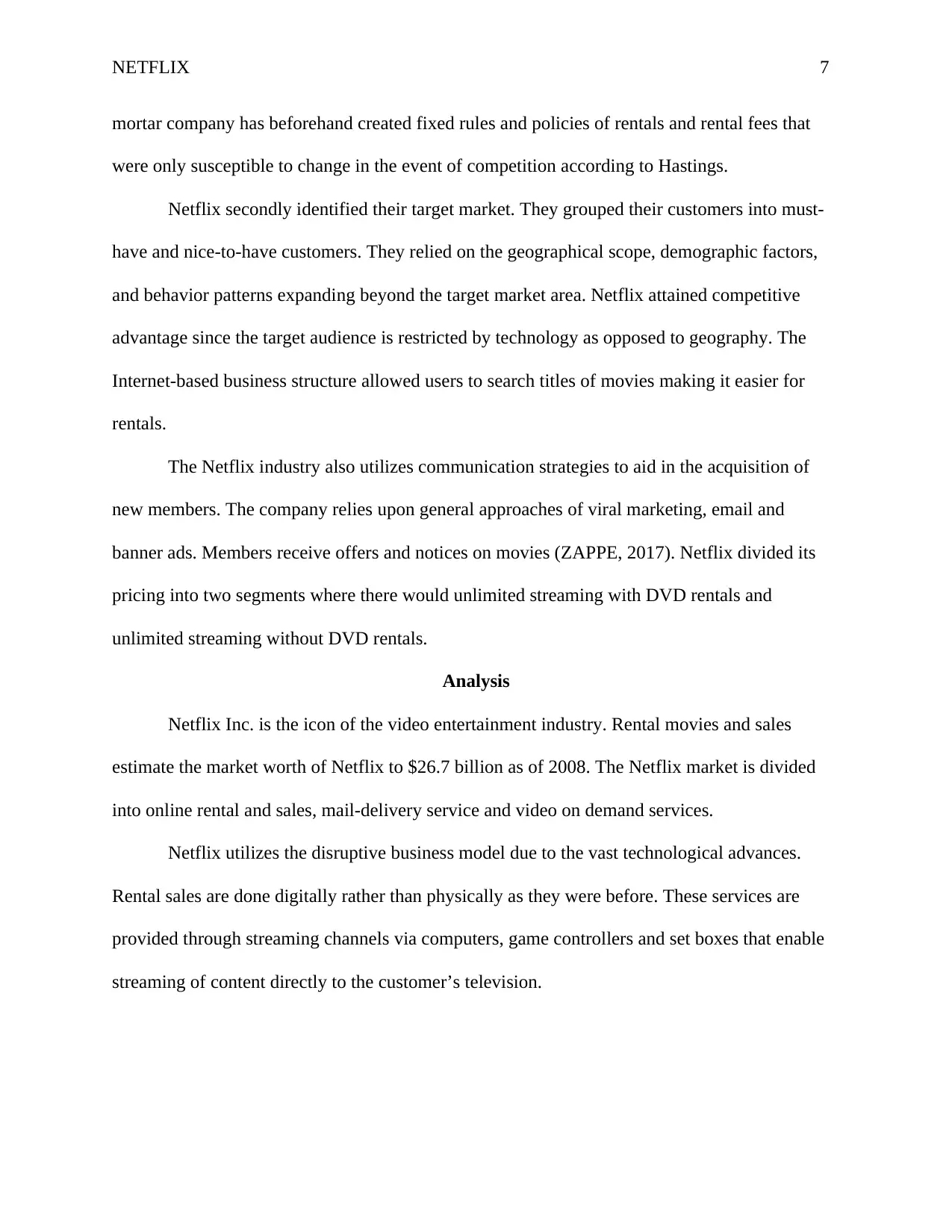
NETFLIX 7
mortar company has beforehand created fixed rules and policies of rentals and rental fees that
were only susceptible to change in the event of competition according to Hastings.
Netflix secondly identified their target market. They grouped their customers into must-
have and nice-to-have customers. They relied on the geographical scope, demographic factors,
and behavior patterns expanding beyond the target market area. Netflix attained competitive
advantage since the target audience is restricted by technology as opposed to geography. The
Internet-based business structure allowed users to search titles of movies making it easier for
rentals.
The Netflix industry also utilizes communication strategies to aid in the acquisition of
new members. The company relies upon general approaches of viral marketing, email and
banner ads. Members receive offers and notices on movies (ZAPPE, 2017). Netflix divided its
pricing into two segments where there would unlimited streaming with DVD rentals and
unlimited streaming without DVD rentals.
Analysis
Netflix Inc. is the icon of the video entertainment industry. Rental movies and sales
estimate the market worth of Netflix to $26.7 billion as of 2008. The Netflix market is divided
into online rental and sales, mail-delivery service and video on demand services.
Netflix utilizes the disruptive business model due to the vast technological advances.
Rental sales are done digitally rather than physically as they were before. These services are
provided through streaming channels via computers, game controllers and set boxes that enable
streaming of content directly to the customer’s television.
mortar company has beforehand created fixed rules and policies of rentals and rental fees that
were only susceptible to change in the event of competition according to Hastings.
Netflix secondly identified their target market. They grouped their customers into must-
have and nice-to-have customers. They relied on the geographical scope, demographic factors,
and behavior patterns expanding beyond the target market area. Netflix attained competitive
advantage since the target audience is restricted by technology as opposed to geography. The
Internet-based business structure allowed users to search titles of movies making it easier for
rentals.
The Netflix industry also utilizes communication strategies to aid in the acquisition of
new members. The company relies upon general approaches of viral marketing, email and
banner ads. Members receive offers and notices on movies (ZAPPE, 2017). Netflix divided its
pricing into two segments where there would unlimited streaming with DVD rentals and
unlimited streaming without DVD rentals.
Analysis
Netflix Inc. is the icon of the video entertainment industry. Rental movies and sales
estimate the market worth of Netflix to $26.7 billion as of 2008. The Netflix market is divided
into online rental and sales, mail-delivery service and video on demand services.
Netflix utilizes the disruptive business model due to the vast technological advances.
Rental sales are done digitally rather than physically as they were before. These services are
provided through streaming channels via computers, game controllers and set boxes that enable
streaming of content directly to the customer’s television.
Paraphrase This Document
Need a fresh take? Get an instant paraphrase of this document with our AI Paraphraser
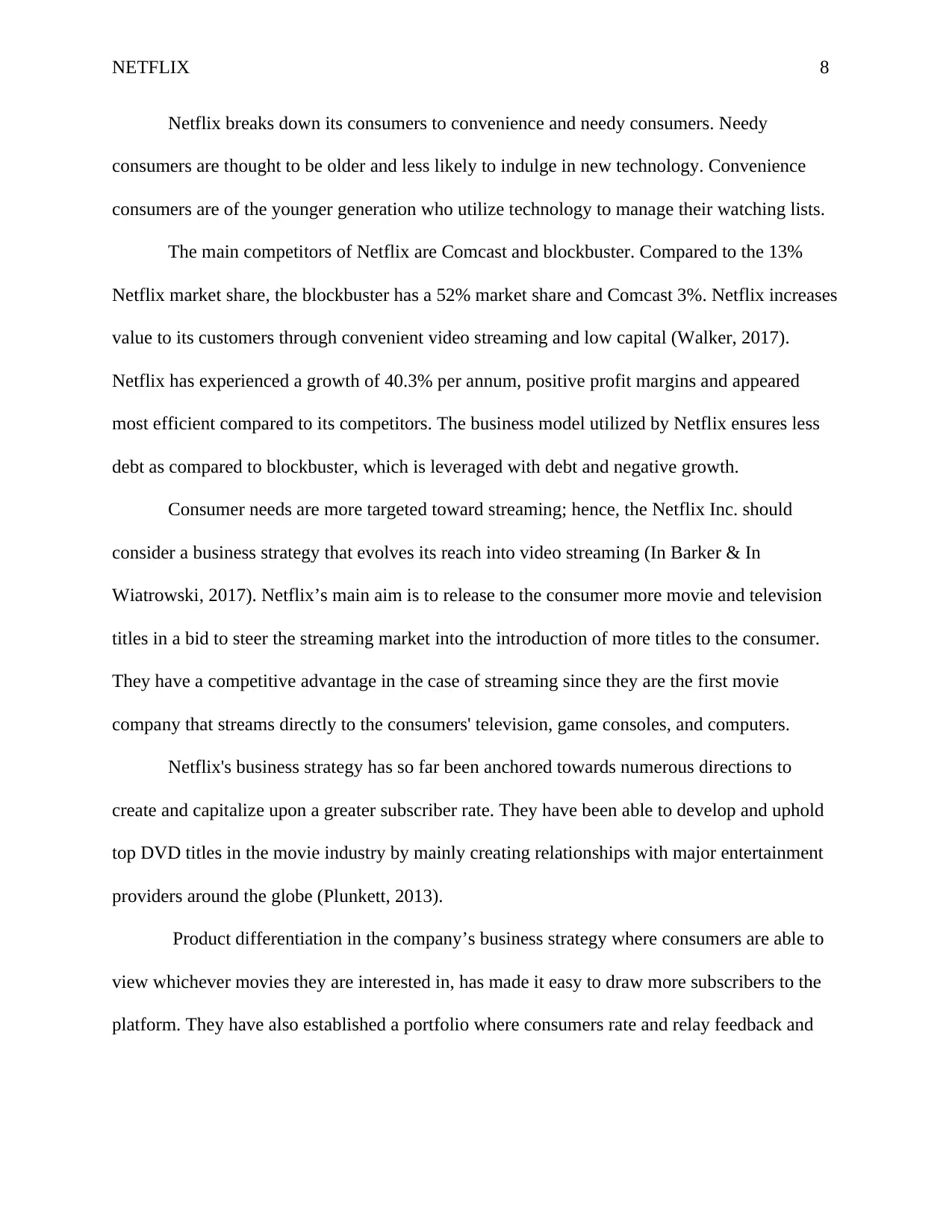
NETFLIX 8
Netflix breaks down its consumers to convenience and needy consumers. Needy
consumers are thought to be older and less likely to indulge in new technology. Convenience
consumers are of the younger generation who utilize technology to manage their watching lists.
The main competitors of Netflix are Comcast and blockbuster. Compared to the 13%
Netflix market share, the blockbuster has a 52% market share and Comcast 3%. Netflix increases
value to its customers through convenient video streaming and low capital (Walker, 2017).
Netflix has experienced a growth of 40.3% per annum, positive profit margins and appeared
most efficient compared to its competitors. The business model utilized by Netflix ensures less
debt as compared to blockbuster, which is leveraged with debt and negative growth.
Consumer needs are more targeted toward streaming; hence, the Netflix Inc. should
consider a business strategy that evolves its reach into video streaming (In Barker & In
Wiatrowski, 2017). Netflix’s main aim is to release to the consumer more movie and television
titles in a bid to steer the streaming market into the introduction of more titles to the consumer.
They have a competitive advantage in the case of streaming since they are the first movie
company that streams directly to the consumers' television, game consoles, and computers.
Netflix's business strategy has so far been anchored towards numerous directions to
create and capitalize upon a greater subscriber rate. They have been able to develop and uphold
top DVD titles in the movie industry by mainly creating relationships with major entertainment
providers around the globe (Plunkett, 2013).
Product differentiation in the company’s business strategy where consumers are able to
view whichever movies they are interested in, has made it easy to draw more subscribers to the
platform. They have also established a portfolio where consumers rate and relay feedback and
Netflix breaks down its consumers to convenience and needy consumers. Needy
consumers are thought to be older and less likely to indulge in new technology. Convenience
consumers are of the younger generation who utilize technology to manage their watching lists.
The main competitors of Netflix are Comcast and blockbuster. Compared to the 13%
Netflix market share, the blockbuster has a 52% market share and Comcast 3%. Netflix increases
value to its customers through convenient video streaming and low capital (Walker, 2017).
Netflix has experienced a growth of 40.3% per annum, positive profit margins and appeared
most efficient compared to its competitors. The business model utilized by Netflix ensures less
debt as compared to blockbuster, which is leveraged with debt and negative growth.
Consumer needs are more targeted toward streaming; hence, the Netflix Inc. should
consider a business strategy that evolves its reach into video streaming (In Barker & In
Wiatrowski, 2017). Netflix’s main aim is to release to the consumer more movie and television
titles in a bid to steer the streaming market into the introduction of more titles to the consumer.
They have a competitive advantage in the case of streaming since they are the first movie
company that streams directly to the consumers' television, game consoles, and computers.
Netflix's business strategy has so far been anchored towards numerous directions to
create and capitalize upon a greater subscriber rate. They have been able to develop and uphold
top DVD titles in the movie industry by mainly creating relationships with major entertainment
providers around the globe (Plunkett, 2013).
Product differentiation in the company’s business strategy where consumers are able to
view whichever movies they are interested in, has made it easy to draw more subscribers to the
platform. They have also established a portfolio where consumers rate and relay feedback and
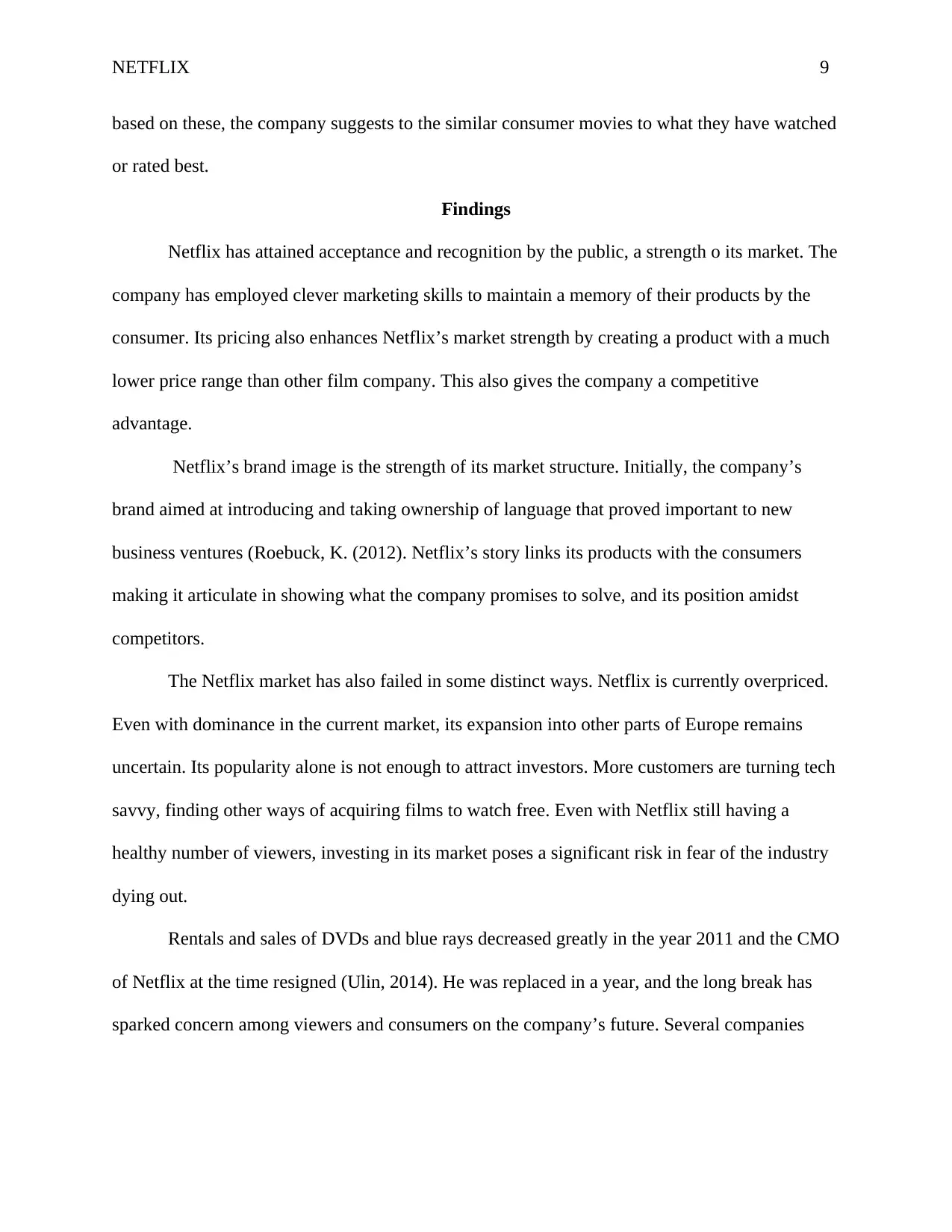
NETFLIX 9
based on these, the company suggests to the similar consumer movies to what they have watched
or rated best.
Findings
Netflix has attained acceptance and recognition by the public, a strength o its market. The
company has employed clever marketing skills to maintain a memory of their products by the
consumer. Its pricing also enhances Netflix’s market strength by creating a product with a much
lower price range than other film company. This also gives the company a competitive
advantage.
Netflix’s brand image is the strength of its market structure. Initially, the company’s
brand aimed at introducing and taking ownership of language that proved important to new
business ventures (Roebuck, K. (2012). Netflix’s story links its products with the consumers
making it articulate in showing what the company promises to solve, and its position amidst
competitors.
The Netflix market has also failed in some distinct ways. Netflix is currently overpriced.
Even with dominance in the current market, its expansion into other parts of Europe remains
uncertain. Its popularity alone is not enough to attract investors. More customers are turning tech
savvy, finding other ways of acquiring films to watch free. Even with Netflix still having a
healthy number of viewers, investing in its market poses a significant risk in fear of the industry
dying out.
Rentals and sales of DVDs and blue rays decreased greatly in the year 2011 and the CMO
of Netflix at the time resigned (Ulin, 2014). He was replaced in a year, and the long break has
sparked concern among viewers and consumers on the company’s future. Several companies
based on these, the company suggests to the similar consumer movies to what they have watched
or rated best.
Findings
Netflix has attained acceptance and recognition by the public, a strength o its market. The
company has employed clever marketing skills to maintain a memory of their products by the
consumer. Its pricing also enhances Netflix’s market strength by creating a product with a much
lower price range than other film company. This also gives the company a competitive
advantage.
Netflix’s brand image is the strength of its market structure. Initially, the company’s
brand aimed at introducing and taking ownership of language that proved important to new
business ventures (Roebuck, K. (2012). Netflix’s story links its products with the consumers
making it articulate in showing what the company promises to solve, and its position amidst
competitors.
The Netflix market has also failed in some distinct ways. Netflix is currently overpriced.
Even with dominance in the current market, its expansion into other parts of Europe remains
uncertain. Its popularity alone is not enough to attract investors. More customers are turning tech
savvy, finding other ways of acquiring films to watch free. Even with Netflix still having a
healthy number of viewers, investing in its market poses a significant risk in fear of the industry
dying out.
Rentals and sales of DVDs and blue rays decreased greatly in the year 2011 and the CMO
of Netflix at the time resigned (Ulin, 2014). He was replaced in a year, and the long break has
sparked concern among viewers and consumers on the company’s future. Several companies
⊘ This is a preview!⊘
Do you want full access?
Subscribe today to unlock all pages.

Trusted by 1+ million students worldwide
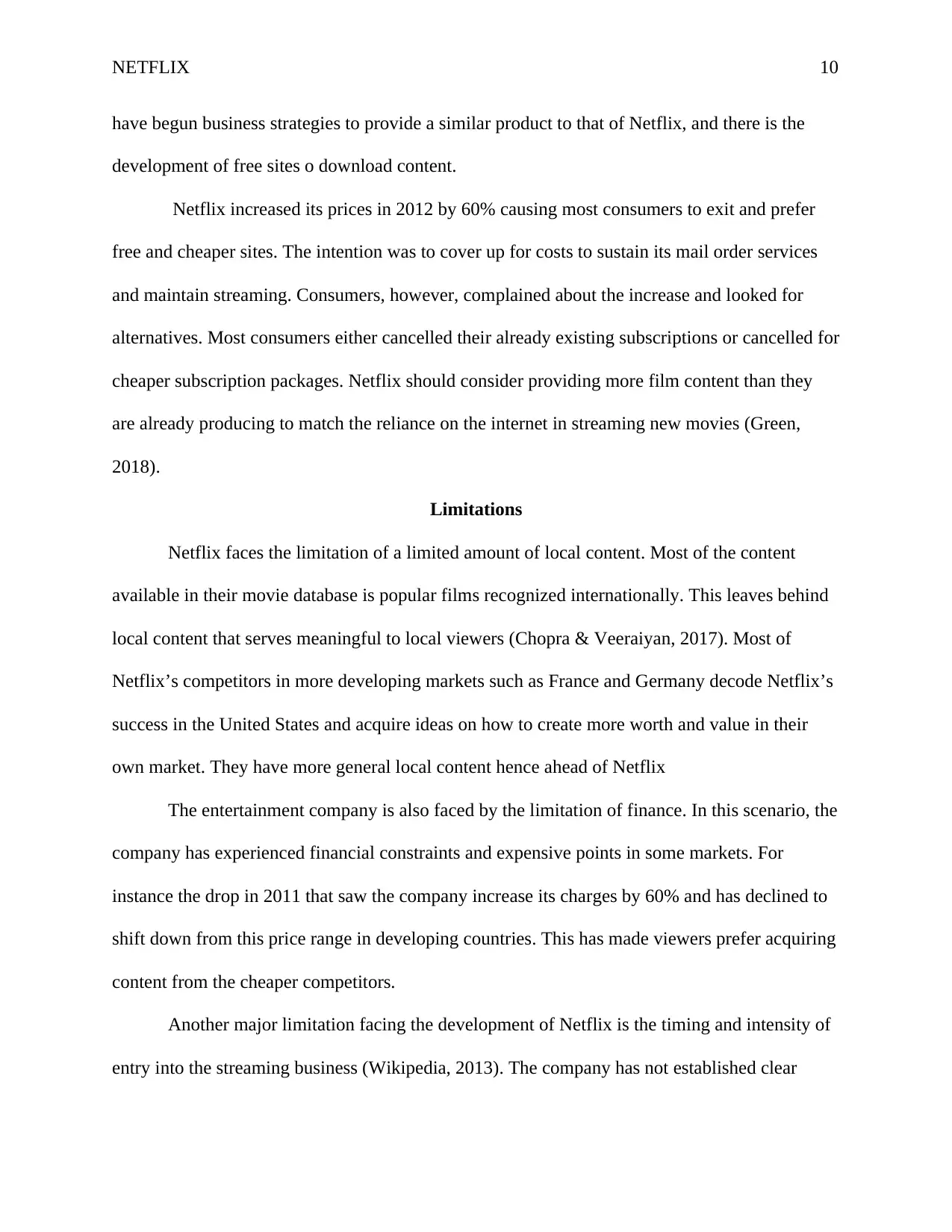
NETFLIX 10
have begun business strategies to provide a similar product to that of Netflix, and there is the
development of free sites o download content.
Netflix increased its prices in 2012 by 60% causing most consumers to exit and prefer
free and cheaper sites. The intention was to cover up for costs to sustain its mail order services
and maintain streaming. Consumers, however, complained about the increase and looked for
alternatives. Most consumers either cancelled their already existing subscriptions or cancelled for
cheaper subscription packages. Netflix should consider providing more film content than they
are already producing to match the reliance on the internet in streaming new movies (Green,
2018).
Limitations
Netflix faces the limitation of a limited amount of local content. Most of the content
available in their movie database is popular films recognized internationally. This leaves behind
local content that serves meaningful to local viewers (Chopra & Veeraiyan, 2017). Most of
Netflix’s competitors in more developing markets such as France and Germany decode Netflix’s
success in the United States and acquire ideas on how to create more worth and value in their
own market. They have more general local content hence ahead of Netflix
The entertainment company is also faced by the limitation of finance. In this scenario, the
company has experienced financial constraints and expensive points in some markets. For
instance the drop in 2011 that saw the company increase its charges by 60% and has declined to
shift down from this price range in developing countries. This has made viewers prefer acquiring
content from the cheaper competitors.
Another major limitation facing the development of Netflix is the timing and intensity of
entry into the streaming business (Wikipedia, 2013). The company has not established clear
have begun business strategies to provide a similar product to that of Netflix, and there is the
development of free sites o download content.
Netflix increased its prices in 2012 by 60% causing most consumers to exit and prefer
free and cheaper sites. The intention was to cover up for costs to sustain its mail order services
and maintain streaming. Consumers, however, complained about the increase and looked for
alternatives. Most consumers either cancelled their already existing subscriptions or cancelled for
cheaper subscription packages. Netflix should consider providing more film content than they
are already producing to match the reliance on the internet in streaming new movies (Green,
2018).
Limitations
Netflix faces the limitation of a limited amount of local content. Most of the content
available in their movie database is popular films recognized internationally. This leaves behind
local content that serves meaningful to local viewers (Chopra & Veeraiyan, 2017). Most of
Netflix’s competitors in more developing markets such as France and Germany decode Netflix’s
success in the United States and acquire ideas on how to create more worth and value in their
own market. They have more general local content hence ahead of Netflix
The entertainment company is also faced by the limitation of finance. In this scenario, the
company has experienced financial constraints and expensive points in some markets. For
instance the drop in 2011 that saw the company increase its charges by 60% and has declined to
shift down from this price range in developing countries. This has made viewers prefer acquiring
content from the cheaper competitors.
Another major limitation facing the development of Netflix is the timing and intensity of
entry into the streaming business (Wikipedia, 2013). The company has not established clear
Paraphrase This Document
Need a fresh take? Get an instant paraphrase of this document with our AI Paraphraser
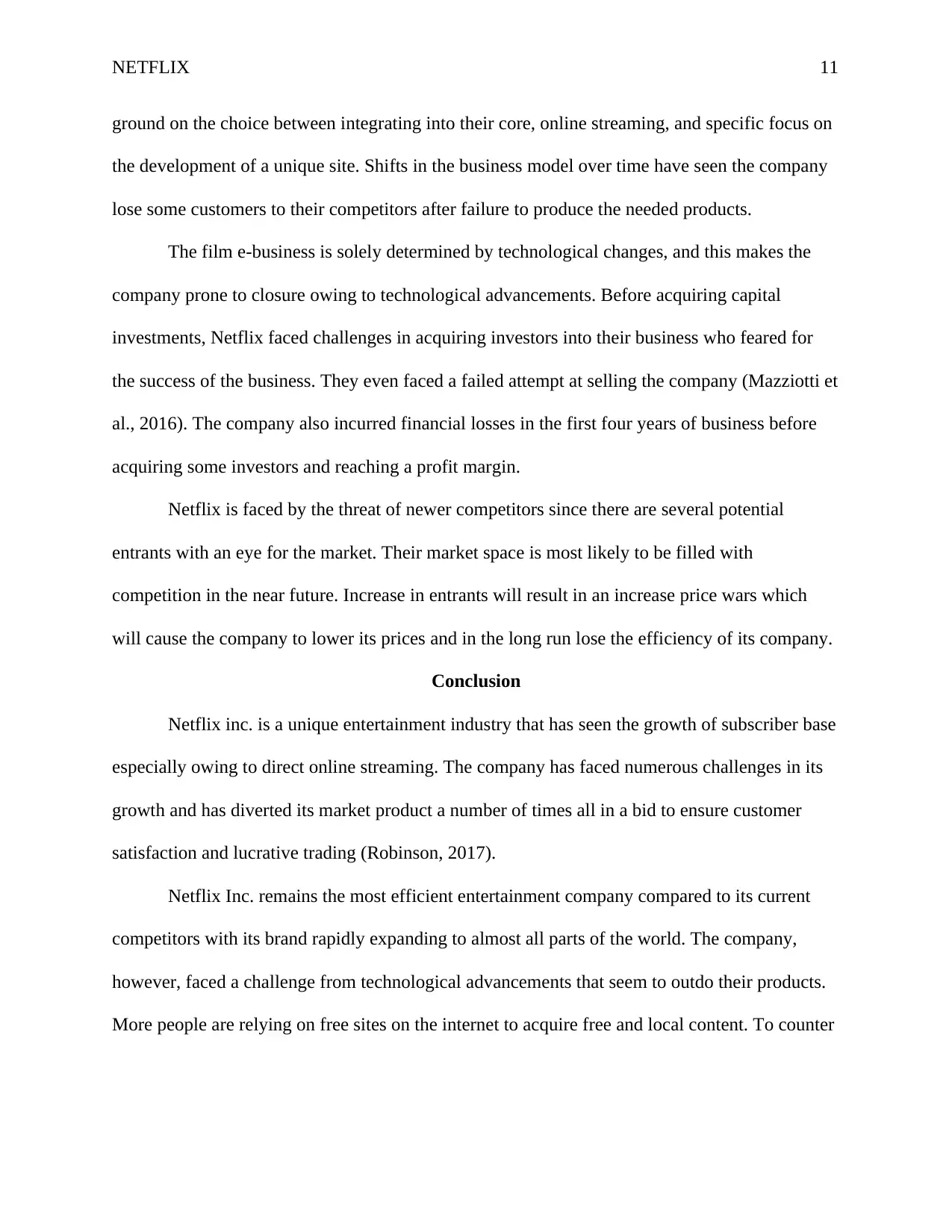
NETFLIX 11
ground on the choice between integrating into their core, online streaming, and specific focus on
the development of a unique site. Shifts in the business model over time have seen the company
lose some customers to their competitors after failure to produce the needed products.
The film e-business is solely determined by technological changes, and this makes the
company prone to closure owing to technological advancements. Before acquiring capital
investments, Netflix faced challenges in acquiring investors into their business who feared for
the success of the business. They even faced a failed attempt at selling the company (Mazziotti et
al., 2016). The company also incurred financial losses in the first four years of business before
acquiring some investors and reaching a profit margin.
Netflix is faced by the threat of newer competitors since there are several potential
entrants with an eye for the market. Their market space is most likely to be filled with
competition in the near future. Increase in entrants will result in an increase price wars which
will cause the company to lower its prices and in the long run lose the efficiency of its company.
Conclusion
Netflix inc. is a unique entertainment industry that has seen the growth of subscriber base
especially owing to direct online streaming. The company has faced numerous challenges in its
growth and has diverted its market product a number of times all in a bid to ensure customer
satisfaction and lucrative trading (Robinson, 2017).
Netflix Inc. remains the most efficient entertainment company compared to its current
competitors with its brand rapidly expanding to almost all parts of the world. The company,
however, faced a challenge from technological advancements that seem to outdo their products.
More people are relying on free sites on the internet to acquire free and local content. To counter
ground on the choice between integrating into their core, online streaming, and specific focus on
the development of a unique site. Shifts in the business model over time have seen the company
lose some customers to their competitors after failure to produce the needed products.
The film e-business is solely determined by technological changes, and this makes the
company prone to closure owing to technological advancements. Before acquiring capital
investments, Netflix faced challenges in acquiring investors into their business who feared for
the success of the business. They even faced a failed attempt at selling the company (Mazziotti et
al., 2016). The company also incurred financial losses in the first four years of business before
acquiring some investors and reaching a profit margin.
Netflix is faced by the threat of newer competitors since there are several potential
entrants with an eye for the market. Their market space is most likely to be filled with
competition in the near future. Increase in entrants will result in an increase price wars which
will cause the company to lower its prices and in the long run lose the efficiency of its company.
Conclusion
Netflix inc. is a unique entertainment industry that has seen the growth of subscriber base
especially owing to direct online streaming. The company has faced numerous challenges in its
growth and has diverted its market product a number of times all in a bid to ensure customer
satisfaction and lucrative trading (Robinson, 2017).
Netflix Inc. remains the most efficient entertainment company compared to its current
competitors with its brand rapidly expanding to almost all parts of the world. The company,
however, faced a challenge from technological advancements that seem to outdo their products.
More people are relying on free sites on the internet to acquire free and local content. To counter
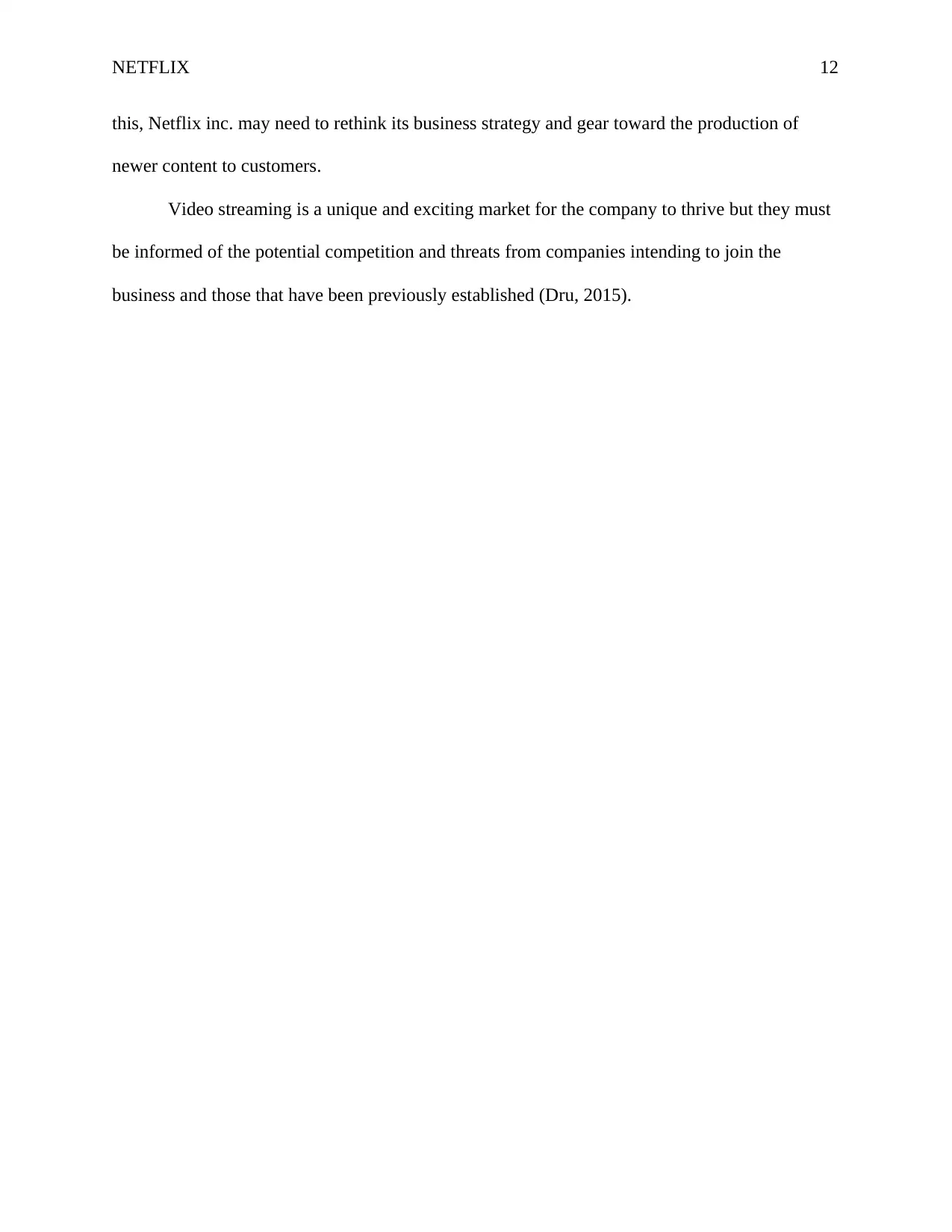
NETFLIX 12
this, Netflix inc. may need to rethink its business strategy and gear toward the production of
newer content to customers.
Video streaming is a unique and exciting market for the company to thrive but they must
be informed of the potential competition and threats from companies intending to join the
business and those that have been previously established (Dru, 2015).
this, Netflix inc. may need to rethink its business strategy and gear toward the production of
newer content to customers.
Video streaming is a unique and exciting market for the company to thrive but they must
be informed of the potential competition and threats from companies intending to join the
business and those that have been previously established (Dru, 2015).
⊘ This is a preview!⊘
Do you want full access?
Subscribe today to unlock all pages.

Trusted by 1+ million students worldwide
1 out of 14
Related Documents
Your All-in-One AI-Powered Toolkit for Academic Success.
+13062052269
info@desklib.com
Available 24*7 on WhatsApp / Email
![[object Object]](/_next/static/media/star-bottom.7253800d.svg)
Unlock your academic potential
Copyright © 2020–2025 A2Z Services. All Rights Reserved. Developed and managed by ZUCOL.




